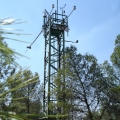In honor of Tu Bishvat, the holiday of trees – where to plant a forest?
Date: January 28, 2021
In the year 2000, Prof. Dan Yakir, the 2019 Israel prize recipient for Earth sciences, established the research station in the Yatir forest in order to explore the interplay between vegetation, the atmosphere, and the climate system. Recent findings from data analysis of the measurements conducted at the station indicate a considerable carbon sink potential in semiarid soils and forest plantations, and imply that afforestation of even 10% of semiarid land area under conditions similar to that of the study site, could sequester ~400 billion kg of carbon per year over several decades.

In the year 2000, Prof. Dan Yakir, the 2019 Israel prize recipient for Earth sciences, established the research station in the Yatir forest in order to explore the interplay between vegetation, the atmosphere, and the climate system. The Yatir forest was planted in the 1960’s in a semi-arid zone, on the edge of the Negev desert, at the boundary of the global forest zone. Semi-arid areas cover nearly 20% of the world’s continents, inhabiting approximately a third of the world’s population. However, research on forests in semi-arid zones is scarce. The measurement station is a part of an international collaboration, covering ~600 stations worldwide. The station measures hundreds of parameters, including carbon, water and energy fluxes. One of the gravest issues the world is facing today is climate change and global warming, associated with greenhouse gases, such as carbon dioxide. Since plants fixate carbon dioxide though photosynthesis, thereby contributing to cooling of the atmosphere. On the other hand, light absorption by the dark forest results in decrease in albedo and warming of the atmosphere. To determine where would be best to plant a forest the effect of carbon fixation versus the radiative effect of the forest need to be quantified. The greater the effect of carbon fixation, the more efficient the forest is in cooling the system.

The Yatir tower reasearch station
A paper from 2019 by the Yakir group, summarizing 15 years (2001–2016) of carbon flux measurements in the Yatir forest presents some interesting findings. Results imply that in semi-arid areas, such as the Yatir forest, carbon accumulates mostly in the soil (over 70%), with a long residence time of ~60 years (compared to ~20 years in temperate zones), due to the very slow carbon decomposition rates under dry conditions. Analysis of combined carbon stock and eddy covariance flux measurements, performed by Rafat Qubaja, a PhD student in the group, show that, as a result of these conditions, the forest accumulated in total ~ 8,000 Tons of carbon per km2 throughout the study period. The results support a considerable carbon sink potential in semiarid soils and forest plantations, and imply that afforestation of even 10% of semiarid land area under conditions similar to that of the study site, could sequester ~400 billion kg of carbon per year over several decades.
